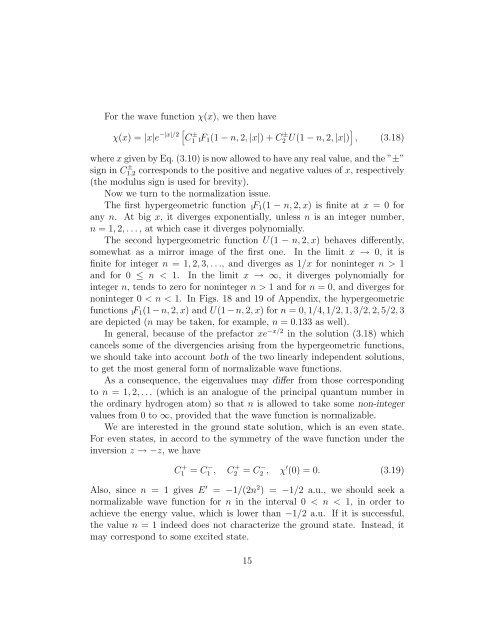Toroidal configuration of the orbit of the electron of the hydrogen ...
Toroidal configuration of the orbit of the electron of the hydrogen ...
Toroidal configuration of the orbit of the electron of the hydrogen ...
Create successful ePaper yourself
Turn your PDF publications into a flip-book with our unique Google optimized e-Paper software.
For <strong>the</strong> wave function χ(x), we <strong>the</strong>n haveχ(x) = |x|e −|x|/2 [ C ± 1 1F 1 (1 − n, 2, |x|) + C ± 2 U(1 − n, 2, |x|) ] , (3.18)where x given by Eq. (3.10) is now allowed to have any real value, and <strong>the</strong> ”±”sign in C 1,2 ± corresponds to <strong>the</strong> positive and negative values <strong>of</strong> x, respectively(<strong>the</strong> modulus sign is used for brevity).Now we turn to <strong>the</strong> normalization issue.The first hypergeometric function 1 F 1 (1 − n, 2, x) is finite at x = 0 forany n. At big x, it diverges exponentially, unless n is an integer number,n = 1, 2, . . . , at which case it diverges polynomially.The second hypergeometric function U(1 − n, 2, x) behaves differently,somewhat as a mirror image <strong>of</strong> <strong>the</strong> first one. In <strong>the</strong> limit x → 0, it isfinite for integer n = 1, 2, 3, . . ., and diverges as 1/x for noninteger n > 1and for 0 ≤ n < 1. In <strong>the</strong> limit x → ∞, it diverges polynomially forinteger n, tends to zero for noninteger n > 1 and for n = 0, and diverges fornoninteger 0 < n < 1. In Figs. 18 and 19 <strong>of</strong> Appendix, <strong>the</strong> hypergeometricfunctions 1 F 1 (1 − n, 2, x) and U(1 − n, 2, x) for n = 0, 1/4, 1/2, 1, 3/2, 2, 5/2, 3are depicted (n may be taken, for example, n = 0.133 as well).In general, because <strong>of</strong> <strong>the</strong> prefactor xe −x/2 in <strong>the</strong> solution (3.18) whichcancels some <strong>of</strong> <strong>the</strong> divergencies arising from <strong>the</strong> hypergeometric functions,we should take into account both <strong>of</strong> <strong>the</strong> two linearly independent solutions,to get <strong>the</strong> most general form <strong>of</strong> normalizable wave functions.As a consequence, <strong>the</strong> eigenvalues may differ from those correspondingto n = 1, 2, . . . (which is an analogue <strong>of</strong> <strong>the</strong> principal quantum number in<strong>the</strong> ordinary <strong>hydrogen</strong> atom) so that n is allowed to take some non-integervalues from 0 to ∞, provided that <strong>the</strong> wave function is normalizable.We are interested in <strong>the</strong> ground state solution, which is an even state.For even states, in accord to <strong>the</strong> symmetry <strong>of</strong> <strong>the</strong> wave function under <strong>the</strong>inversion z → −z, we haveC + 1 = C − 1 , C + 2 = C − 2 , χ ′ (0) = 0. (3.19)Also, since n = 1 gives E ′ = −1/(2n 2 ) = −1/2 a.u., we should seek anormalizable wave function for n in <strong>the</strong> interval 0 < n < 1, in order toachieve <strong>the</strong> energy value, which is lower than −1/2 a.u. If it is successful,<strong>the</strong> value n = 1 indeed does not characterize <strong>the</strong> ground state. Instead, itmay correspond to some excited state.15














